Finishing the facade with stone gives the building a respectable look of an ancient castle. Decorative imitation has become an alternative to expensive natural material. Artificial stone for the facade is presented in a wide range of textures and colors. It is affordable, and with a competent architectural design, it is not inferior to the aesthetics of natural counterparts.
- Varieties of artificial stone for the facade and their characteristics
- Clinker
- Polymer sandy
- Concrete
- Synthetic resin based
- Ceramic
- Rules for choosing a material for finishing
- Mounting options
- Adhesive base
- Curtain facade
- Types of stone masonry when finishing the facade
- Facing for masonry from dies
- Masonry finish "Castle"
- Laying under masonry "Plateau"
- Masonry "Rondo"
- Masonry "Shakhriyar"
- Masonry "Assol"
- Advantages and disadvantages of using decorative stone
Varieties of artificial stone for the facade and their characteristics
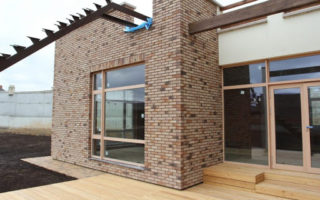
Artificial stone is the general name for a building material that has become a replacement for natural. The imitation looks attractive and is much cheaper. Products are classified according to the type of raw material from which they are made. The technology for creating a facade decorative stone takes into account the conditions of its operation. The material is moisture resistant, insensitive to high and low temperatures.
Clinker
For the first time clinker stone appeared in Holland. It is made from refractory clays. The material is characterized by increased frost resistance, reliably protects the facade from moisture. In terms of durability and strength, clinker is close to natural stone. It comes in brick, tile or sandstone form.
Polymer sandy
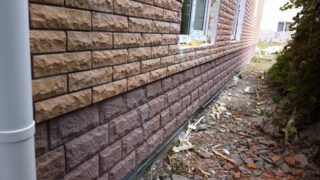
The product contains polymers, sand filler and inorganic pigment for painting.
During manufacture, the ingredients are mixed and heated. The material is plastic, waterproof and resistant to low temperatures.
Finishing slabs replicate brickwork or torn stone.
Polymer sandy facades have low thermal conductivity, the finish is easy to install, and is sold at an affordable price.
Concrete
The main components of the products are: white or gray cement, sand, stone chips, gypsum and coloring pigments. With the help of mineral additives, the desired color and texture is achieved. Products are cast in molds, giving them the desired size and shape. There is an imitation of marble and granite. Concrete wall stones are of high weight and strength. They are affordable, therefore they are popular when decorating houses.
Synthetic resin based
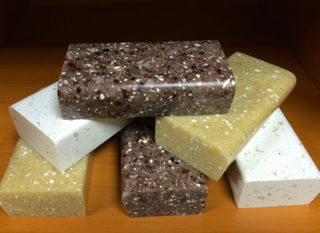
Facade stone made of synthetic resins and waste from natural mineral processing is the most realistic in the decor. Creates an authentic imitation of marble, granite, limestone, labradorite or sandstone. Products are made in square or rectangular shape, with a smooth or embossed surface.
Ceramic
Artificial stone on the wall, made of clay, can withstand any weather conditions. It is produced in the form of a tile, sometimes with a glossy glazed or embossed surface. Despite the advantages, the material is rarely used for cladding.
Due to the different physical characteristics of the ceramics and the adhesive composition, the tiles quickly peel off the walls.
Rules for choosing a material for finishing
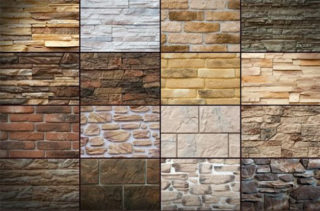
The cladding material is evaluated in terms of appearance and performance. In order for the finish to serve for a long time and emphasize the architectural style of the house, it is necessary to take into account the advice on choosing from professional builders:
- Color quality - products must have uniform coloring. It is achieved by observing the technology in the factory.
- Uniformity - The store usually has a tile that is broken in half for display to customers. The interior should have a uniform structure without large particles or pores. Errors arise when the proportions of the ingredients are not observed, the strength of such a product will be low.
- The back surface, which is responsible for adhesion with the adhesive, must be rough; grooves are cut in some products.
- The color of the cladding is selected in accordance with the architectural style of the building. Muted dark or light shades are suitable for classics, modern buildings are good in bright colors.
Price is one of the indicators of the quality of the finishing material. A manufacturer using reliable, expensive components cannot sell products at prices lower than the average market value.
Finishing stone for the exterior walls of the house does not require certification. In order not to buy material from an unscrupulous company, you should find out information about the manufacturer, read reviews about his product.
Mounting options
There are two ways to install the cladding: on the glue solution and on the lathing. In the second case, fastening is performed with self-tapping screws or clamps.
Adhesive base
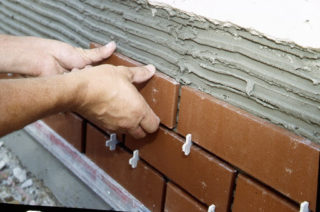
The installation of the facade stone for the exterior decoration of the house with the glue method is carried out using special soluble mixtures and grouting. This is the most common option. Before installation, the surface of the walls is covered with soil. The dry mixture is diluted with water according to the manufacturer's instructions. The stone tiles are pre-arranged on the boardwalk. The laying starts from the corner of the building, a metal profile is installed under the first row. It is advisable to buy special corner pieces. The mortar is applied to the wall and tiles with a notched trowel. If necessary, trimming of parts is carried out. The features of the masonry depend on the chosen method.
Curtain facade
The method is suitable for decorative stone produced in the form of panels. A crate made of a metal profile is attached to the facade. The horizontal and vertical guides are level. There is free space between the wall and the trim for ventilation. For fixing the plates, metal staples are often used - clamps. The disadvantage of this method is the high cost of work and material.
Types of stone masonry when finishing the facade
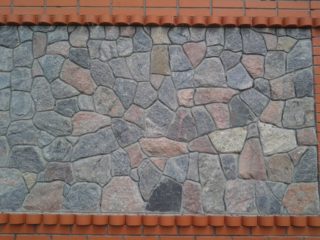
The architectural appearance of the house depends on the beauty of the stone used and the way of masonry. The cladding process is laborious and requires experience and artistic taste.
Facing for masonry from dies
A common budget method that allows you to show the beauty of the material without special processing of the ends and surfaces. It is necessary to have an artistic taste so that the laid parts of different shapes and sizes look aesthetically pleasing.
Masonry finish "Castle"
The medieval castle-style design is created from rectangular stones with a torn outside. After the completion of the installation, the walls of the house become embossed, similar to the serfs. Thanks to the clear shape, laying and joining the tiles is easy. Difficulties are caused by the different dimensions of the components. It is better to entrust the work to a master finisher.
Laying under masonry "Plateau"

For finishing, a material with processed ends is selected. Slabs can be square and rectangular, in size they are multiples of 5 cm. The surface of the stone is polished or chipped. This method is popular for cladding individual parts of the facade - corners, plinths, doors and windows.
Masonry "Rondo"
The walls are covered with stones with smoothly polished ends.They take on a rounded shape, like sea pebbles. A feature of the technology is the sequence of stone laying. Large parts are distributed first, then free space is filled with small ones. This option is recommended for lovers of marine motifs in architecture.
Masonry "Shakhriyar"
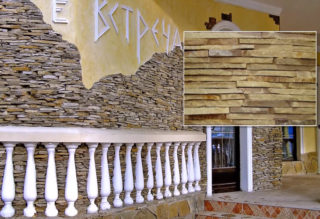
The method is easy to install, therefore it is cheaper than other types. The cladding uses rectangular elements of the same size. Their edges are processed, from the front side there is a rustication (a narrow smooth strip) along the perimeter. When using products with a polished or sanded surface, the result is reminiscent of brickwork. Most often, rough or chipped stone is used to give natural aesthetics.
Masonry "Assol"
For cladding, long rectangular elements are used, differing in thickness. The dies are stacked with the end, the front side looks embossed. The difficulty of the work lies in achieving a balance of stones with different parameters.
Advantages and disadvantages of using decorative stone
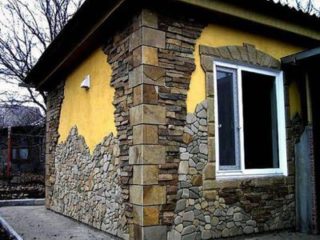
Any finishing material is not perfect; it has its own advantages and disadvantages. When choosing, it is worth evaluating the weight of the arguments for and against.
Benefits:
- Light weight gives minimal additional load on the foundation of the building.
- The material is non-flammable, therefore fire safety is increased.
- The use of environmentally friendly ingredients makes the products safe.
- Finishing is additional heat and sound insulation.
- Artificial stone is affordable for many buyers.
- Decorative cladding is represented by a huge assortment of products in various shades and textures.
Disadvantages:
- In terms of service life it is inferior to natural analogues.
- Insufficient resistance to temperature changes.
- Low resistance to UV rays.
Artificial stone for wall cladding is widely used in architecture. It allows you to faithfully reproduce the beauty of natural materials, to create an individual appearance of the building.








